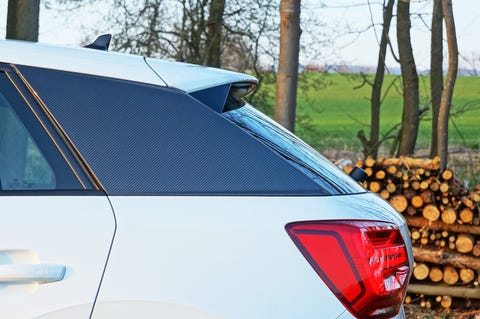In the Old World, where cities and towns were built long before the invention of the automobile, parking spaces and roads are usually pretty small. Consequently, drivers prefer vehicles that fit in this world. But smaller doesn’t have to mean lesser in any way other than size, and that’s why Audi builds the Q2 crossover, a vehicle a full size below the globally offered Q3.
Now four years old, the Q2’s dates back an early era in Audi design, an era marked by chiseled lines and sharp creases. In an attempt to update the Q2’s look, there’s a new grille to bring it in line with the other Q models. Aside from that, nothing else changed. But the Q2 looks good for a compact crossover, vehicles that too often end up with the proportions of a potato. To create some individuality, buyers can choose to have the fat C-pillars painted a contrasting color or enhanced with stickers. The vehicle we drove wore a carbon-fiber motif on its C-pillars, which, from a distance, makes them look like an extension of the side windows.
Inside, the layout mimics the angular theme of current Audis, although the steering wheel and the circular air vents look a bit dated when compared with other vehicles in the lineup. The matte finish on the instrument panel is acceptable, but the door panels are hard plastic. And while the assembly quality is great, we wish that Audi would offer more premium materials inside the Q2, particularly since this vehicle competes with several sister models from other VW brands. Audi needs to differentiate its interior quality from that of its siblings.
As is expected in the segment, the Q2’s seating position is elevated and the driver and front-seat passenger have plenty of space. There isn’t a lot of legroom, but the rear seat proves family friendly—ideal for kids and workable for adults on short trips. The cargo space is easily accessible and surprisingly vast, given the dimensions of the car.
European customers face choosing between diesel and gasoline engines ranging from 114 horsepower all the way up to the SQ2’s 296 horses. We drove the second most powerful gasoline model, a turbocharged 2.0-liter inline-four that makes 188 horsepower. The engine is lashed to a seven-speed dual-clutch automatic that drives all four wheels.
The 188-hp unit moves the Q2 with considerable authority. Audi claims that the sprint to 62 mph takes just 6.5 seconds and that the top speed is a strong-for-a-tiny-crossover 142 mph. This engine is delightfully responsive, with virtually no turbo lag, and it makes silky sounds, not moans or buzzes. The dual-clutch box performs its tasks with perfection. Our main regret is the fact that Audi has purged the manual transmission from the higher-powered models, which makes us wonder whether the torquey 148-hp diesel might be an even better choice for enthusiasts who don’t want to splurge for the 296-hp (and automatic-only) SQ2.
Our test drive being in late winter, our Q2 still wore winter tires, and the Michelin Alpin 5 rubber made its presence known with a slight whistle. But otherwise, the Q2 performed well. We thought it felt most harmonious in Comfort mode, which is not pillowy soft but offers a very good ride-handling compromise. The steering is extraordinarily direct at low speeds, but it mellows out and doesn’t feel nervous at autobahn speeds.
When pushed to the limit, the Q2 exhibits slight understeer, and it keeps great control on rough and uneven surfaces. The brakes are impressively sharp and strong. The trade-off for the Q2’s elevated seating position and high center of gravity is small: This crossover feels like a slightly taller A3.
A facelift is coming either later this year or in early 2021, not that we’ll see it on our shores. That said, we think that the Q2 would be an interesting choice for urban dwellers who want a small premium ute but not the Mercedes-Benz GLA250. The Q2 deserves a chance to succeed in America. For the time being, it’ll remain in Europe, where it’ll continue to compete with the slightly larger BMW X1 and the like-sized GLA.
This content is created and maintained by a third party, and imported onto this page to help users provide their email addresses. You may be able to find more information about this and similar content at piano.io










